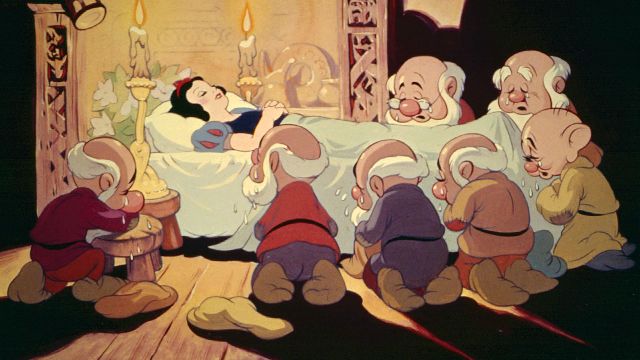Snow White and the Seven Dwarfs (1937) 
“See for yourself what the genius of Walt Disney has created in his first full-length feature production.”

Director: William Cottrell, David Hand, Wilfred Jackson, Larry Morey, Perce Pearce, Ben Sharpsteen
Cast: Adriana Caselotti, Harry Stockwell, Lucille La Verne
Synopsis: Snow White runs away from the castle, driven out by the Evil Queen and finds warmth in a home of seven dwarves.
Watch this and other movies on Sky Cinema
Snow White and the Seven Dwarfs has won its place in history thanks to its position as Walt Disney’s first feature-length movie, but time has not been particularly kind to it. Inevitably, much of its animation looks dated today. That’s not the fault of the film, of course; it was made when it was made and should really be judged by the standards and expectations of its day. That’s not easy, however, particularly when the animation’s datedness is not tempered by an element of nostalgic charm. This doesn’t apply so much to the dwarfs — they’re parodies, and animation styles haven’t changed so much in that department — but the standard-sized humans, including Snow White, lack the kind of detail we have come to expect from animation movies. That’s not to argue that computer-generated animation is superior to hand-drawn — in fact, the opposite is true; the more movies pursue their quest to create an animation that’s indistinguishable from the real thing the further they part from the true spirit of animation — it’s just that time is far less forgiving of old animations featuring human figures than it is of equally old live action movies.
Snow White and the Seven Dwarfs only really comes alive with the appearance of the dwarfs. Although Snow White’s terrified flight through the bewitched forest is a high point that’s almost as frightening as the scene in Pinocchio in which misbehaving boys find themselves turning into donkeys, it’s surrounded by a sea of insufferable high-pitched warbling and a menagerie of overly cute birds, rabbits and deer. Snow White, a princess exploited by a wicked stepmother jealous of her step-daughter’s beauty, flees into the forest when the huntsman tasked with slaying her can’t go through with it. She’s guided to the dwarf’s cottage by all those cute animals — who must, we have to assume, provide much of the food the dwarfs need to survive — and immediately sets about tidying up the example of male slovenliness she finds there. This is the 1930s, after all — an age when women were widely assumed to have no other function or desire than to keep house and raise children. This unnatural state of tidiness causes much consternation amongst the dwarfs when they return home from a day’s toiling in the mines while Snow White is taking a nap upstairs. But after convincing themselves that she’s not some strange house-cleaning demon, there begins a period of domestic bliss, which is only threatened when Snow White’s wicked stepmother is informed by her magic mirror that her step-daughter is still alive.
There’s not that much story to Snow White and the Seven Dwarfs, with as much time being devoted to the little fellows having a wash and a dance as to any plot development. The humour is of a gentle nature, not only because it’s aimed primarily at kids but because of the era to which it belongs. It might raise a smile or too today, but little or no laughter. The antics of the dwarfs would still amuse very young children, and no doubt those for whom the film played a major part of their childhood will remain entranced, but for the rest of us Snow White and the Seven Dwarfs is something of a shrugged-shoulders movie. We might be able to appreciate the technical expertise that went into making it, but find only limited enjoyment from what we see.
(Reviewed 8th October 2014)
httpv://www.youtube.com/watch?v=ncMKymAOy1I
